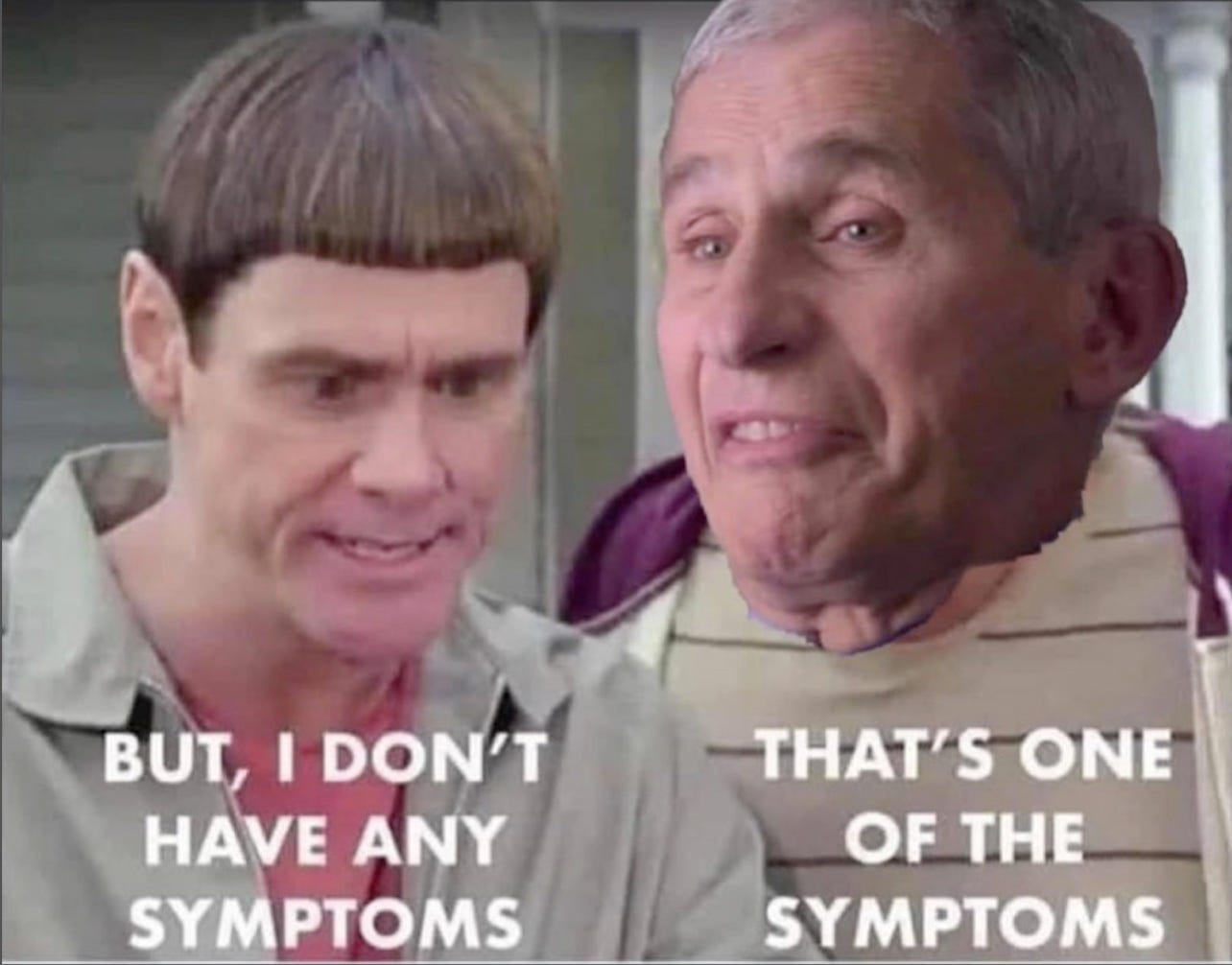The King's Chessboard
Why PCR testing is not the best tool for this job
I’m a bit of a math geek, but it’s not my fault. Both of my grandmothers were teachers. Both mom and dad taught physics and math. My older brother teaches physics and math. My other 2 older brothers have PhD’s in physics and engineering. I avoided the scourge only narrowly, veering out of studying physics and math in university and into medicine. (My epiphany came to me one day as I was struggling to follow the lesson in a grad school course called “Advanced Radiation Physics”. I looked around to see if anyone else was feeling as confused as me, and realized I was giving up about 30 IQ points to all the guys around me. The only lasting lesson from that course for me was :never take a university course with “advanced” in the title. Always take “Basics of...” or “An introduction to...”.)
Anyway, getting back on track, I always loved mathematical problems. Dad and mom would play math games with us as kids. “If there were 10 little birds on the tree, and 4 more came, how many birds would be there then?”. As we grew older the puzzles got more complicated. I remember being flummoxed by Zeno’s paradox when I was about 12, and am happy to see that much greater minds remain unsettled on the answer.
One of my favourite mathematical constructs is “The King’s Chessboard”. To summarize, a wise man was offered a reward of his choice if he won a game of chess. Fabulous wealth? Lands? The princess’s hand in marriage? No, the wise man said. All he asked was for an amount of grain. How much? One grain for the first square of the chessboard, 2 for the 2nd, 4 for the 3rd, 8 for the 4th, and so on to the end. The greedy king quickly agreed, thinking he was getting a deal. He didn’t realize that he had agreed to give the wise man over 18 QUINTILLION grains, which is over 2000 times the current yearly world production of wheat. The king got “owned”, literally in this case.
In many aspects of life, people don’t realize the power of compound interest (let alone doubling, as the grains on the chessboard). That 1.5% fee you pay to your financial planner per year means by the end of your 30 year career he has 50% of your money. That 5% population growth per year due to immigration might look nice economically, but in 14 years you’ll have twice as many people – twice the burden on roads/sewers/etc. Beware compounding! Some even say that “The greatest shortcoming of the human race is our inability to understand the exponential function”.
PCR testing
Trump was polarizing if nothing else. During his tenure, many normally reasonable people were guilty of a cognitive error sometimes referred to as “the genetic fallacy” – dismissing or endorsing an argument based on its source, rather than on the argument’s merits. If Trump said black, the answer must be white. If he said go north, they would go south. Border shutdowns were racist when Trump did it, and wonderful when Trudeau imposed them.
I recall a normally very reasonable friend (who had a severe case of TDS - Trump Derangement Syndrome) snorting and sneering at a statement by Trump fairly early in the pandemic that “if we didn’t do any testing, we wouldn’t have any cases”. To give The Great Tangerine credit, if you read his full statement at that time, he didn’t say that COVID would go away without testing. And even for those who think that Trump is a broken clock, he can still be right twice a day. He had a point.
PCR is an amazing, revolutionary technology. It allows us to replicate DNA samples by doubling to produce enough protein to do tests on. (The story on how this is done is amazing in itself!) If someone was in your house last week, their DNA is there, but not nearly enough to find on a test. But if we double the sample, and double it again, and double it again... Then we get enough to test. Each 10 doublings increases the amount of material by approximately 1000. Double another 10 times and your 1000 is now 1 million. Another 10 times for a billion. And another 10 times for a trillion. And that is the number of doublings – or “cycle threshold” - that many PCR tests were set to - 40. They multiply the genetic material on the swab by 1 trillion.
So if you had sniffed in half of a virus, or had been sick a few weeks ago and had a few shards of dead virus in your nose, or had been exposed but were fighting it off and were never going to get sick or infectious, you could test positive.
False positives vs. false negatives
There is an inherent tension in designing and tuning a test for a disease. A good analogy is if you have a motion detector burglar alarm on your house. If set too sensitively, it will go off every time a bird flies by your window, or any time your cat gets off his blanket (not very often for my cat, but…). In epidemiology, this is called a “false positive” - the alarm went off but no burglar. Set the sensitivity too low, and Hughie and Louie can stomp around your house in their steel toes while they carry off your big screen TV and the alarm still won’t trigger. In epidemiology this is a false negative - no alarm, but the burglar struck. The challenge is finding the happy medium where a big cat won’t set it off, but a small burglar will.
To get slightly technical, this is the balance between sensitivity (detecting cases) and specificity (a positive result is truly positive - it’s not just your cat). In practice, no test is perfect and we trade off higher sensitivity for lower specificity, or vice-versa, as we “tune” the test, as we would tune the burglar alarm.
Under some circumstances, a very sensitive test is desirable. For instance, let’s say I have a patient who I already know has viral meningitis. I’m trying to find out what virus caused it. A very sensitive test (like PCR) is perfect, because I’m not really worried about false positives.
But what about testing asymptomatic people for COVID? This is a different kettle of fish.
Sensitivity and Specificity in Action
Let’s say my test is very sensitive – it picks up 100% of cases and never misses one. But one in 1000 cases where the patient does NOT have COVID, the test tells me he does. Doesn’t sound like a big deal, right? That means 99.9% of the time (999 times out of 1000) a patient without COVID will test negative.
But apply that to Nova Scotia through most of the pandemic. Let’s say we’re screening a big number of people every day – let’s say 5000 just to take a round number. Then let’s assume we have 200 active cases in the province at that time (through most of the pandemic we’ve had less). In a province of a million (again, round numbers for easy math), that means one in 5,000 people has COVID.
So if we randomly screen 5000 people, we would expect one of them to actually have COVID.
But now remember that 1 in 1000 patients who are actually COVID-free will test positive. That means out of the 5000 patients, 6 will test positive for COVID, but only one will actually have COVID. So there are 5:1 odds that the positive test is actually false. 5 people get locked in their homes for 2 weeks, get stressed that they may have potentially killed their sick grandma who they just visited, they have to miss work, etc.
When we restrict the test only to people who are actually sick, and more likely have COVID, these numbers change a lot. For instance, let’s say the test is used just for SICK people with fever and cough or other possible COVID symptoms. And let’s say that out of every 1000 people with fever and cough, 50 of them actually have COVID. The other 950 just have run-of-the-mill bugs that we don’t stress about as much.
Apply our test again to the 1000 sick patients. We pick up all 50 of the COVID cases. We still get one false positive, but now we have 50:1 odds that the positive test was true positive - the test subject does actually have COVID.
This is why the question “Do you think the PCR test is accurate” is not a good question. The answer is yes. And no. If used appropriately, in the correct group of patients, it is a great test. If used indiscriminately, it’s a debacle. Which is kinda what we did.
The “Choosing Wisely” initiative was created to teach patients, doctors, and healthcare workers that more is not always better in medicine. And that includes testing, for the reasons outlined above. Test too many of the wrong people and your test becomes useless. Before COVID, the right answer on “who should we test?” was never “EVERYBODY!”.
What is a “Case”
When a layperson hears the word “case”, they think someone who is sick. As in “John has a bad case of the flu and landed in hospital”.
Prior to COVID, the definition of a “case” in the epidemiological world was indeed a person with symptoms, who tested positive for the disease. John would need to be tested for flu to confirm that was what was making him sick. Once his test was positive he would count as a “case” of the flu.
The first part of that is important: someone WITH symptoms. That part has been thrown out specially for COVID. Now a “case” is anyone who tested positive, for most of the pandemic that means positive on an extremely sensitive PCR test.
A useful test would actually pick up patients with COVID who are capable of spreading it to others but not test positive on those who aren’t infectious. A PCR test does the former well, but fails on the latter issue.
Imagine for a minute if every flu season we obsessively tested huge portions of the population for influenza? How many positive tests do you think we would have? Lots of those sniffles are actually caused by influenza. Vaccines have limited efficacy most years. Many people have even milder symptoms. Or no symptoms.
Remember previous flu years how thousands of people lined up in the cold for hours waiting for a test, even though they felt fine? Can’t recall? No, me neither. That’s because we didn’t. Because that would have been ridiculous, right?





Thank you so much for explaining the details of the PCR test. It makes us who have been screaming that the PCR test is causing mayham feel a little less crazy! Who would ever guess they'd run a campaign of "sick until proven well.".
Thanks for the much needed, well explained information about the PCR testing! Now if the mainstream media would report this!!!! Totally agree with your view on what occurred with the election of Trump….common sense has become a rarity these days. So nice to read such truth…and who doesn’t love the Big Bang Theory 🤪!